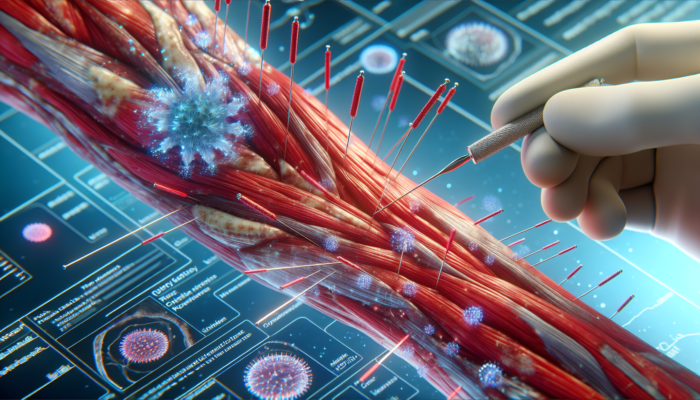Proven Acupuncture Methods for Alleviating Tendonitis Discomfort
Understanding Tendonitis: Key Causes and Symptoms You Need to Recognize

Acupuncture for tendonitis relief is recognized as a highly effective approach to addressing this painful inflammatory condition that specifically targets the tendons—robust, fibrous tissues that connect muscles to bones. Tendonitis often develops from repetitive strain, overuse injuries, or acute trauma, making individuals across various professions susceptible. Athletes, manual laborers, and even office workers are at an increased risk of suffering from tendonitis due to the physical demands associated with their jobs. Commonly identified types of this condition include tennis elbow, Achilles tendonitis, and rotator cuff tendonitis, each presenting unique challenges that necessitate customized treatment strategies.
The symptoms linked to tendonitis typically appear as localized pain, tenderness, swelling around the affected joint, and increased stiffness that becomes more pronounced during movement. These limitations can drastically interfere with daily activities and significantly diminish one’s overall quality of life. Recognizing these symptoms early is essential for timely intervention and effective recovery. If you are currently experiencing any of these signs, seeking professional support through Acupuncture for tendonitis treatment could be a crucial step towards alleviating your discomfort and regaining your ability to function normally.
Unpacking the Science Behind Acupuncture's Healing Approach
<a href="https://mcrtherapies.co.uk/acupuncture-for-skin-conditions-discover-transformative-relief/">Acupuncture</a> is a time-honored therapeutic practice with deep roots in Traditional Chinese Medicine (TCM), characterized by the precise insertion of ultra-fine needles into specific points on the body. From a Western medical perspective, this practice is thought to stimulate the nervous system, resulting in the release of neurotransmitters and hormones that play a crucial role in alleviating pain and minimizing inflammation.
Within the context of tendonitis, acupuncture offers remarkable advantages. By harmonizing the body’s energy, referred to as Qi, acupuncture not only reduces discomfort but also aids in restoring normal physiological functions. The strategic placement of needles can activate the body's natural healing processes, boosting blood flow to the affected areas, which is vital for effective recovery. This integrative approach—balancing energy while promoting healing—positions acupuncture as a compelling treatment option for individuals dealing with tendonitis.
Research Evidence Supporting Acupuncture's Effectiveness
A substantial body of scientific literature has highlighted the efficacy of Acupuncture for tendonitis treatment. For example, a systematic review published in a respected medical journal found that patients receiving acupuncture for various tendonitis-related conditions experienced significant pain relief compared to those who did not undergo any treatment. Additional clinical trials have confirmed acupuncture's capacity to reduce inflammation and speed up healing times.
Researchers emphasize acupuncture's effectiveness in enhancing localized blood circulation, a critical element for tendon recovery. A thorough review of these studies indicates that acupuncture transcends being merely an alternative therapy; it is a scientifically validated method for effectively managing tendonitis.
Implementing Acupuncture for Effective Relief from Tendonitis Discomfort

Identifying and Stimulating Key Trigger Points for Optimal Relief
Acupuncturists are specially trained to pinpoint specific trigger points associated with tendonitis, where tension and discomfort often accumulate due to repetitive movements or excessive strain. By inserting needles into these targeted areas, practitioners can effectively reduce inflammation and alleviate pain.
For instance, in cases of tennis elbow, needles are often skillfully inserted around the elbow joint and in the forearm to relieve tension and stimulate the healing process. This focused methodology not only addresses immediate symptoms but also resolves underlying issues contributing to discomfort, such as muscle imbalances or poor posture.
Ultimately, this targeted approach can lead to significant pain relief and restoration of function, empowering patients to resume their daily activities without the debilitating effects of tendonitis hindering their progress.
Boosting Blood Circulation and Healing Through Acupuncture
A remarkable advantage of acupuncture lies in its ability to enhance blood circulation throughout the body. Improved blood flow is essential for healing, as it delivers vital nutrients and oxygen to damaged tissues. When targeting tendonitis, acupuncture significantly boosts circulation to the affected tendons, which can accelerate the recovery process.
Research shows that enhanced circulation not only alleviates pain but also supports the body’s inherent repair mechanisms. As tendons heal more rapidly, patients often notice a reduction in stiffness and an increase in mobility, facilitating a more active lifestyle post-treatment. This highlights the importance of incorporating acupuncture for tendonitis treatment as a vital component of a comprehensive recovery strategy.
Integrating Acupuncture with Complementary Therapeutic Approaches

Acupuncture can be smoothly integrated with various therapeutic modalities for a holistic approach to managing tendonitis. For instance, the pain-relieving effects of acupuncture can significantly enhance the efficacy of physical therapy, allowing patients to participate more actively in their rehabilitation exercises.
Moreover, combining acupuncture with medication can optimize pain management strategies. While medications may offer immediate relief, acupuncture addresses the root causes of discomfort, helping to prevent recurrences. This synergistic approach not only enhances overall outcomes but also empowers patients to take an active role in managing their tendon health.
Customized Acupuncture Techniques for Various Types of Tendonitis
Targeting Tennis Elbow with Specialized Acupuncture Approaches
Tennis elbow, clinically referred to as lateral epicondylitis, is characterized by pain on the outer elbow caused by repetitive overuse. Acupuncture techniques specifically tailored to treat this condition typically involve placing needles along the forearm, elbow, and shoulder areas.
Research supports the effectiveness of specific acupuncture points, such as LI10 and LI11, in alleviating pain associated with tennis elbow. By stimulating these key points, acupuncturists can effectively diminish inflammation and promote healing in the affected tendons, delivering rapid relief and improving functional outcomes for patients.
Many patients report significant reductions in pain levels after just a few treatment sessions, making acupuncture a highly desirable adjunctive option for individuals looking to enhance traditional therapeutic methods.
Utilizing Acupuncture for Effective Management of Achilles Tendonitis
Achilles tendonitis can be particularly painful and limiting for athletes. Acupuncture offers a unique and effective method for managing this type of tendonitis. By focusing on specific acupuncture points around the ankle and calf muscles, acupuncturists can effectively reduce inflammation while improving circulation to the affected area.
Common acupuncture points such as GB34 and BL57 are recognized for alleviating symptoms related to Achilles tendonitis. Clinical evidence supports acupuncture’s role in enhancing flexibility and reducing pain in the Achilles tendon, ultimately allowing individuals to return to their athletic pursuits more quickly.
Additionally, acupuncture can help lower the risk of recurrence by addressing potential biomechanical factors that may have contributed to the initial onset of the tendonitis.
Managing Pain and Enhancing Mobility in Rotator Cuff Tendonitis Treatments
Rotator cuff tendonitis is a prevalent issue characterized by pain and limited mobility in the shoulder region. Acupuncture plays a crucial role in managing this condition by targeting specific points around the shoulder and upper back to relieve tension and promote healing.
Key acupuncture points, such as SI9 and LI15, are frequently utilized to effectively alleviate shoulder pain. This targeted approach can enhance the range of motion and decrease stiffness, enabling patients to engage in daily activities without discomfort.
When included in a comprehensive rehabilitation program, acupuncture can greatly enhance recovery outcomes, making it an invaluable resource for anyone coping with rotator cuff tendonitis.
Your Comprehensive Guide to an Acupuncture Session for Tendonitis Treatment
Initial Consultation: Comprehensive Health Assessment for Personalized Care
Your journey into acupuncture for tendonitis treatment begins with an initial consultation. During this critical visit, the acupuncturist will conduct a thorough health history assessment, discussing your symptoms, lifestyle, and any previous treatments you have undergone. This detailed evaluation is vital for determining the most effective course of action tailored to your unique needs.
Be prepared to share information regarding your pain levels, the duration of your symptoms, and any factors that may exacerbate your condition. This comprehensive understanding is crucial for developing a personalized treatment plan that effectively addresses your situation and promotes optimal healing outcomes.
Step-by-Step Overview of the Acupuncture Procedure
During an acupuncture session, you will lie down comfortably while the acupuncturist prepares to insert needles into designated points on your body. These needles are exceptionally thin, and most patients report minimal to no discomfort during the insertion process.
The acupuncturist may leave the needles in place for approximately 20 to 30 minutes. During this time, you might feel relaxation and warmth as your body responds to the treatment, facilitating healing and pain relief.
Some patients may feel slightly groggy after the session, while others may experience a surge of energy. It is essential to communicate any sensations you experience during the treatment to your acupuncturist, as this feedback can help tailor adjustments for future sessions.
Post-Treatment Care: The Importance of Follow-Up Sessions for Optimal Recovery
After an acupuncture session, mild soreness or tenderness in the treated areas is common. This sensation is usually slight and subsides quickly. Your acupuncturist may provide specific aftercare instructions, such as avoiding strenuous activities for a brief period or applying heat to the treated area to enhance relaxation.
Follow-up sessions are crucial for monitoring your progress and adjusting the treatment plan as necessary. Consistent treatments can lead to cumulative benefits, significantly improving your tendonitis symptoms over time.
How to Select the Best Acupuncturist for Effective Tendonitis Treatment
Key Qualifications and Certifications to Ensure Quality Care
When searching for an acupuncturist to address your tendonitis, evaluating their qualifications and certifications is essential. Look for practitioners who have completed accredited acupuncture programs and hold the necessary licenses to practice in their respective regions.
In many jurisdictions, acupuncturists must pass rigorous examinations to practice. Additionally, verifying memberships in professional organizations, such as the National Certification Commission for Acupuncture and Oriental Medicine (NCCAOM), can provide further assurance of their expertise and dedication to high standards.
A well-qualified acupuncturist will possess a robust understanding of anatomy and physiology, especially concerning musculoskeletal conditions like tendonitis, ensuring you receive top-quality care that is tailored to your needs.
Important Questions to Ask Before Starting Acupuncture Treatment
Before embarking on your acupuncture journey, it’s wise to ask potential practitioners several essential questions. Inquire about their experience specifically treating tendonitis, as well as their overall treatment philosophy.
Ask about the typical number of sessions they recommend for your condition and how they assess progress. Additionally, discussing any supplementary therapies they may suggest alongside acupuncture can provide valuable insights. Clarifying the treatment plan will help alleviate any concerns and establish realistic expectations for your healing journey.
The Importance of Patient Reviews and Testimonials in Your Decision-Making Process
Patient reviews and testimonials can provide invaluable insights into an acupuncturist's effectiveness. Look for online reviews on platforms such as Google, Yelp, or specialized healthcare websites.
Positive feedback regarding pain relief and overall satisfaction can indicate a practitioner’s skill level and the quality of patient care they provide. If possible, reach out to former patients to gather firsthand accounts of their experiences, as this can significantly inform your decision-making process.
Maximizing Acupuncture Benefits with Lifestyle and Home Care Strategies
Effective Exercises and Stretches to Alleviate Tendonitis Symptoms
Incorporating targeted exercises and stretches into your daily routine can significantly enhance the benefits of acupuncture for tendonitis treatment. Gentle stretches focusing on the affected area can help maintain flexibility, while strengthening exercises support the surrounding muscles and lessen strain on the tendons.
For example, wrist flexor and extensor stretches are particularly effective in relieving tension in cases of tennis elbow. Similarly, for Achilles tendonitis, calf stretches and range-of-motion exercises can help maintain flexibility and reduce stiffness. Always consult with your acupuncturist or a qualified physical therapist to ensure the exercises are suitable for your specific condition.
Nutrition and Supplements: Supporting Tendon Health for Optimal Recovery
Maintaining a balanced diet rich in anti-inflammatory foods can significantly enhance tendon health and recovery. Incorporating omega-3 fatty acids from fish and flaxseeds, along with antioxidants from a variety of fruits and vegetables, can help effectively combat inflammation and support overall physical well-being.
Moreover, supplements such as collagen, glucosamine, and turmeric may prove beneficial in promoting tendon health and alleviating pain. Always discuss any dietary changes or supplements with your healthcare provider to ensure they align with your treatment plan and overall health.
Preventing Tendonitis Recurrence: Lifestyle Adjustments for Long-Term Health
Adopting lifestyle modifications that support tendon health is crucial for preventing the recurrence of tendonitis after your acupuncture treatment. Implementing proper warm-up and cool-down routines during physical activities can significantly reduce the risk of strain and injury.
Additionally, focusing on ergonomic practices at work and during sports can alleviate unnecessary pressure on your tendons. Engaging regularly in strength training and flexibility exercises will strengthen the muscles surrounding your tendons, enhancing their resilience against injuries.
Taking a proactive approach to maintaining your tendon health, alongside acupuncture treatment, can empower you to lead an active and pain-free lifestyle, free from the limitations caused by tendonitis.
Frequently Asked Questions About Acupuncture and Tendonitis Treatment
What does the acupuncture process for tendonitis treatment entail?
Acupuncture for tendonitis treatment involves the insertion of thin needles into specific points on the body to alleviate pain and encourage healing in the affected tendons.
How many acupuncture sessions are typically necessary for tendonitis?
The number of sessions required can vary among individuals, but many patients notice improvement within 3 to 6 sessions, depending on the severity of their condition.
Is the acupuncture process painful?
Most individuals report minimal discomfort during acupuncture, as the needles are extremely thin. Some may experience a slight tingling or warm sensation during the treatment.
Can acupuncture effectively complement other treatment modalities?
Yes, acupuncture can work synergistically with other treatments such as physical therapy, medication, or massage therapy for comprehensive management of tendonitis.
Are there any side effects associated with acupuncture?
While acupuncture is generally considered safe, some individuals may experience minor soreness or bruising at the needle sites. Serious side effects are rare when the treatment is performed by a qualified practitioner.
How does acupuncture help reduce inflammation?
Acupuncture aids in reducing inflammation by enhancing blood circulation and stimulating the release of anti-inflammatory chemicals within the body.
Can I engage in exercise after an acupuncture session?
It’s advisable to follow your acupuncturist's recommendations. Light stretching is generally encouraged, while strenuous activities should be avoided immediately following treatment.
What is the typical duration of an acupuncture session?
An acupuncture session typically lasts between 30 to 60 minutes, depending on the treatment plan and individual patient needs.
What type of clothing should I wear to an acupuncture appointment?
Wear loose, comfortable clothing that allows easy access to the treatment areas. This facilitates the acupuncture process and ensures a more relaxed experience.
How can I find a qualified acupuncturist?
Look for licensed practitioners with experience specifically in treating tendonitis. Consider checking reviews or asking for referrals to ensure you receive quality care.
Presented By: Tendonitis Relief
The Article: Acupuncture for Tendonitis: Discover Effective Relief appeared first on https://mcrtherapies.co.uk
The Article Acupuncture for Tendonitis: Uncover Effective Solutions appeared first on https://mcrtherapies.com/
The Article Tendonitis Solutions: Discover the Benefits of Acupuncture Was Found On https://limitsofstrategy.com/

